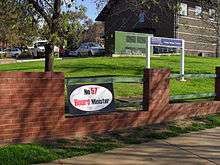New South Wales Teachers Federation
The New South Wales Teachers Federation (also known simply as Federation) is the registered trade union that covers New South Wales (NSW) public school teachers. The New South Wales Teachers Federation represents all teachers in NSW public pre-schools, infants, primary and secondary schools and TAFE (technical and further education) Institutes. Teachers in Schools for Specific Purposes, Adult Migrant Education Service (AMES) and Corrective Services are also members.
| Full name | New South Wales Teachers Federation |
|---|---|
| Members | 66,000 |
| Affiliation | AEU, ACTU |
| Office location | Surry Hills, NSW |
| Country | Australia |
| Website | www.nswtf.org.au |
About the union
The New South Wales Teachers Federation is affiliated to the Australian Education Union (AEU), the national union covering public school teachers in Australia and through that organisation to Education International and the Australian Council of Trade Unions. The New South Wales Teachers Federation is also affiliated to Unions New South Wales. The NSW Teachers Federation is not affiliated to any political party.
The New South Wales Teachers Federation is based at Surry Hills near the Sydney CBD. The union also has regional offices in Blacktown, Bathurst, Dubbo, Lismore, Newcastle, Port Macquarie, Queanbeyan, Tamworth, Wagga Wagga and Wollongong.
The membership includes about 41,000 full-time teachers, 15,000 casual and unemployed members, and 6,000 TAFE teachers. The total membership stands at about 67,000.
The state council of the union consists of approximately 300 locally elected delegates. The union's annual conference consists of approximately 600 delegates. The NSW Teachers Federation executive is elected by the state council.
The secretariat of the Federation is composed of 47 officers who are elected by the council for a three-year term. They perform such jobs as organiser, industrial advocate, welfare officer and research officer, supporting the Federation's membership.
The three Presidential officers – President, Deputy President, and Senior Vice-President – are elected by the whole membership every two years.
The NSW Teachers Federation looks after a multiplicity of issues on behalf of teachers. It is responsible for negotiating the salaries and working conditions of its members with the New South Wales government. The union is committed to the interests of public education, although its primary concern is salaries and working conditions of its members.
Stewart House is the official charity of the NSW Teachers Federation.
History
Establishment and the early years
Throughout its history, Federation has campaigned long and hard on issues affecting public education, teachers' salaries and teachers' working conditions, those issues which are at the heart of teaching as a profession in New South Wales.
The first Annual Conference of Federation in 1919 had listed as part of the agenda "inadequacy of teachers' salaries, understaffing of schools, unwieldiness of classes, insufficiency of accommodation, conducting of classes in sheds, corridors and unsuitable rooms to the detriment of the health of teachers and pupils". Other matters included "unhealthy congestion of school population in overgrown suburban schools, as against decentralisation into schools with a maximum enrolment of one thousand, the high percentage of unclassified and insufficiently trained teachers, inadequacy of supervision by heads of departments owing to class duties and absence of schools for the mentally disabled". Throughout this century, Federation has continued to campaign on these issues.
In the years immediately following its establishment, Federation was concerned to increase its membership. In 1920 the membership of the Federation was 5,600 or 78% of the total membership of the Department of Education. In 1996 membership is about 64,000. This number includes permanent full-time school, TAFE teachers, AMES teachers, part-time school, TAFE, AMES and casual teachers as well as those teachers in other associated groups.
It was not until 1937 that the first organiser was appointed, following an Annual Conference decision of 1936 that stated "we are firmly of the opinion that, for a really effective increase in membership, it is necessary that some person be employed for the whole of their time organising the schools". More officers were progressively appointed. There were 43 full-time administrative officers in 1996, who serviced the needs of the membership and undertook recruitment activities.
1960s-present day
In 1961, 241,000 signatories for a National Education Petition were presented to the Prime Minister, Robert Menzies, calling for Commonwealth funding to state schools. This was the culmination of a long campaign begun in the 1940s, to encourage the Commonwealth Government to fund certain programs in State schools. To this day such programs are funded by the Commonwealth Government. This number of signatories was a record which was only broken in 1993 by a petition calling for private health insurance to be tax deductible.
Over the years to 1968, the year of Federation's first general strike, the Union campaigned on the theme of "United Action", emphasising a community of interest between different sectors of the membership and the community, in policy development. Political, industrial and professional issues concerning public education were given focus and emphasis. There were significant advances – in 1946, for example, there was a major salaries breakthrough for teachers which gave the first realistic salary increases since 1920 and set the standard for other professional workers. The average gain was over 100 pounds for men and 80 pounds for women.
The federation made a major break with the past in 1968, its 50th anniversary, when the first statewide strike was called over the conditions in which teachers were working.

Since the 1990s, the NSW Teachers Federation has campaigned to support public education in the face of rapidly expanding government funding for private schools. In partnership with parents and principals, the Teachers Federation has engaged in political lobbying and advertising in support of public schools.